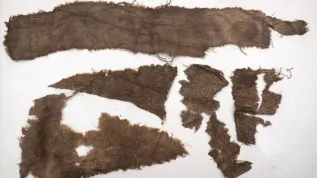
A Bronze-age arrowhead with part of its preserved wooden shaft attached has been found by a history enthusiast searching a dried out lake.
Damian Żuralski from the Historical and Exploratory Association ‘Salla' had been using his metal detector at the lake near Łukta (Warmia-Masuria) when he stumbled upon the arrowhead now being described as ‘a unique find in Poland’.
He said: “We were looking for traces of World War II and accidentally made this discovery. We are very happy, because while the association has existed for over a dozen years, we have been doing field searches only for a year.”
Archaeologist Łukasz Szczepański told the Polish Press Agency PAP: “The arrow head is very interesting, there is no equivalent in Polish lands, which is why we have a problem with its precise dating.
“It comes from the Bronze Age or the early Iron Age. At this stage there are many questions that will be answered only after expert analyses are completed.”
He added that the wooden part of the arrow was preserved for so long because it was in a humid environment.
The most famous discovery of this type was the Dröbnitz Girl (also known as the Drwęck mummy), the remains of a teenage girl buried or sacrificed ca. 600 BCE. The remains were discovered in July 1939 in a bog during peat extraction.
Thanks to tannic acid present in the bog, the body was preserved in excellent condition. It ended up in the Museum in Königsberg, where, like other exhibits, it was destroyed during the Red Army offensive in 1945.
The newly-found arrowhead will now be processed by Dr. Marcin Maciejewski from the Maria Curie-Skłodowska University in Lublin, who specializes in the Bronze Age and early Iron Age.
The find will be subjected to analyses to determine, the age of wood used to make the shaft, raw material composition of metal and the processing method. Researchers will also attempt to determine the type of substance connecting the head with the wooden part of the arrow. (PAP)
author: Marcin Boguszewski
mbo/ aszw/ kap/
tr. RL













